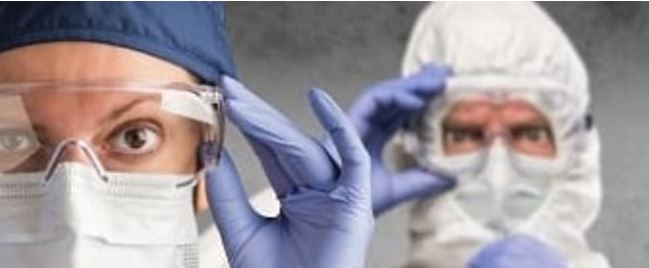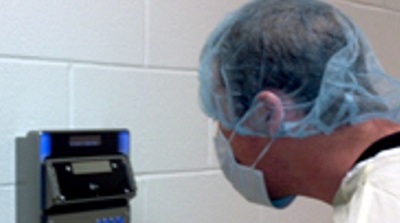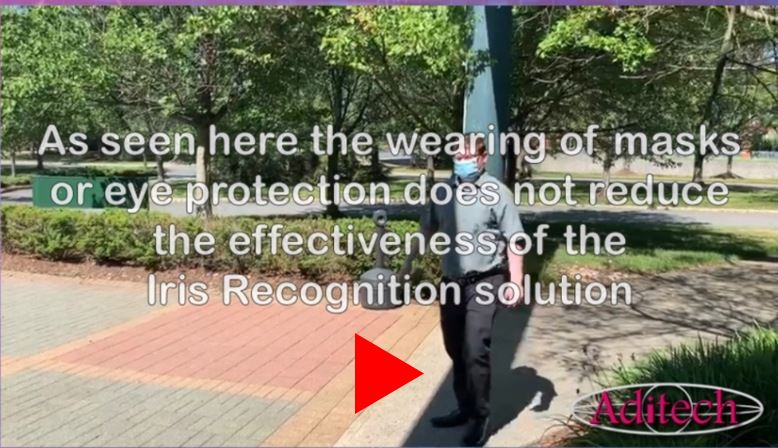Thankyou for registering to view the White Paper and associated Video presentation
Iris Recognition scores over alternative biometric technologies
Facial Recognition and Iris Recognition: The Effects of PPE (Personal Protective Equipment)

Introduction
Following recent NIST testing it has been observed that facial recognition based biometric identification and authorisation solutions are severely impaired by the use of PPE (Personal Protective Equipment) such as face masks, visors and safety goggles, despite claims from facial recognition developers and vendors.
Occlusion of the features required by facial recognition technology results in poor results and both false positives and false negatives are identified. Even the very latest AI (Artificial Intelligence) or HOG (Histogram of Oriented Gradients) technologies are not as yet, capable of dealing with the post-COVID situation we are finding ourselves in.
It is apparent from the NIST study that the only contactless biometric identification technology which functions to an acceptable level when confronted by a subject wearing facial coverings or glasses is Iris Scanning Technology.
 Iris Recognition has long been employed in mission critical environments for biometric access control or time and attendance. The fact that everyone has a unique iris results in extremely high levels of accuracy, reducing false positives and false negatives and providing truly fit for purpose solutions.
Iris Recognition has long been employed in mission critical environments for biometric access control or time and attendance. The fact that everyone has a unique iris results in extremely high levels of accuracy, reducing false positives and false negatives and providing truly fit for purpose solutions.
Iris Recognition has been proven to operate successfully within many hostile environments both indoors and outside* and is unaffected by the wearing of spectacles, contact lenses, visors or safety glasses. There is no need to remove other protective clothing such as gloves to operate the technology as most systems can scan the iris automatically when in range and there is no physical contact with the equipment.
Contact-free Biometrics and the COVID 19 pandemic
It has been identified that there is a significant move away from contact-based biometric systems as a result of the COVID-19 pandemic. This comes at a time when biometric systems, many using fingerprint recognition, are gaining popularity among public and private organisations.
Research studies have shown that viruses and germs can be passed from person to person by touching the same hard surface, like the ones on a fingerprint-based reader or keypad.
This situation recently led to members of the New York City Police Department, to protest about the use of fingerprint time and attendance systems which resulted in the NYPD suspended the used of fingerprint biometrics at its headquarters.
It is clear that the COVID-19 pandemic has changed our lives forever, the reliance on “Contactless” Access Control and Time and Attendance systems requiring a migration from Keys, Cards and Codes to safer COVID-19 compliant solutions employing Iris Recognition and Identification based biometric technology.
Iris Recognition Technology in a practical situation
As you will see from the accompanying video clip, the subject (previously registered with or without PPE) simply approached the equipment, in this case mounted in an external situation. You will see that the subject is wearing both a standard coronavirus safety mask and spectacles which would prevent facial recognition technology from working effectively.
 Click on the image to view video
Click on the image to view video
The equipment identifies the fact that the subject has approached and once in range will scan the subject to identify the iris patterns – No Contact with the equipment is required unlike key-pads or fingerprint readers. As you can hear the equipment requests that the subject moves forward to provide best results. Once identified and authorised access to the building is provided via an interface with the door locking mechanism.
This routine is repeated inside the building this time using the device internally. In both cases, a log of the access is registered within the equipment, data transferred to the access management system if required and a full audit trail maintained.
*Iris Recognition equipment when used outdoors should be suitably protected from the elements and located such to reduce the effects of adverse lighting conditions such as direct sunlight.
NIST Testing of Facial Recognition with COVID Masks
 Biometric facial recognition algorithms developed since the beginning of the COVID-19 pandemic may be able to identify people wearing masks better than legacy algorithms, but even the best ones developed previously do so “with great difficulty” according to the latest testing from the U.S. National Institute of Standards and Technology.
Biometric facial recognition algorithms developed since the beginning of the COVID-19 pandemic may be able to identify people wearing masks better than legacy algorithms, but even the best ones developed previously do so “with great difficulty” according to the latest testing from the U.S. National Institute of Standards and Technology.
NIST tested 89 commercial facial recognition algorithms for the ‘Ongoing Face Recognition Vendor Test (FRVT) Part 6A: Face recognition accuracy with masks using pre-COVID-19 algorithms.’ In testing with digitally applied face masks, even the best algorithms had error rates between 5 and 50 percent in one-to-one matching.
The research team came up with nine mask variants in black or the blue of surgical masks, some just covering the ‘wearer’s’ mouth and nose, while some cover the whole lower face.
 NIST Computer Scientist Mei Ngan, one of the report’s authors, says the test was motivated by the pandemic, and the organization plans to test new algorithms developed with masks in mind later in the summer.
NIST Computer Scientist Mei Ngan, one of the report’s authors, says the test was motivated by the pandemic, and the organization plans to test new algorithms developed with masks in mind later in the summer.
“We can draw a few broad conclusions from the results, but there are caveats,” Ngan notes. “None of these algorithms were designed to handle face masks, and the masks we used are digital creations, not the real thing.”
The accuracy of the algorithms declined substantially in every case. While the top performing algorithm with unmasked faces failed about 0.3 percent of the time, their failure rate was closer to 5 percent for faces occluded with the digital masks. Many “otherwise competent” algorithms failed between 20 and 50 percent of the time. Masked images also caused algorithms to be unable to process the face at all, due to a “failure to enroll or template.” (Source Chris Burt BiometricUpdate)
What the Experts say – “Iris recognition systems to resolve face ID problems amid the COVID pandemic”
Face recognition applications, including its most common commercial use in access control have met serious challenges, which in turn could accelerate and promote the wider use of iris recognition technology, according to Chinese experts and industry leaders.
 “Human iris is one of the most unique biometric characteristics of a human body and it is stable during life, which could be processed as ways to accurately identify individuals and determine if they have access rights.”
“Human iris is one of the most unique biometric characteristics of a human body and it is stable during life, which could be processed as ways to accurately identify individuals and determine if they have access rights.”
Sun Zhenan, a fellow researcher and iris recognition technology expert with the Institute of Automation under the Chinese Academy of Sciences (CAS,) commented, adding, “Iris recognition could resolve technical barriers when face identification is unavailable, as user’s faces are mostly covered by masks.”
“Iris recognition is more accurate and harder to be counterfeited than face recognition, whereas identification data of fingerprints are prone to wear and tear and its collection process involving physical touch could also add to infection risks”
 Paul Stanborough Managing Director of UK based Aditech Ltd. Iris
Paul Stanborough Managing Director of UK based Aditech Ltd. Iris
Recognition Specialists stated. “Since the COVID-19 pandemic hit the world, Interest in Iris Recognition Identification and Authentication Technology has presented itself at the most viable and accurate biometric access and time management technique.”
Paul added. “COVID compliant contactless solutions utilising Iris scanners are clearly the answer to the issues that other biometric technologies are facing, namely the need to be contact-free, operate when the subject is wearing PPE and in particular face coverings and finally, be accurate even then the individual is wearing spectacles or safety goggles. I am finding that enquiries for COVID compliant systems have increased significantly over recent months”
Reference
NIST Test Proves ‘The Eyes Have It’ for ID Verification
(Source NIST – National Institute of Standards and Technology)
A new report by computer scientists at the National Institute of Standards and Technology (NIST) demonstrates that iris recognition algorithms can maintain their accuracy and interoperability with compact images, affirming their potential for large-scale identity management applications such as the federal Personal Identity Verification program, cyber security and counterterrorism.
The aim of this study is to evaluate the performance of iris recognition over operational test data. As a technology evaluation, it is very similar to IREX IV Part 1: Evaluation of Iris Identification Algorithms. However, unlike IREX IV it assesses both verification (one-to-one) and identification (one-to-many) performance. Thirteen research institutions submitted recognition algorithms for evaluation, more than any other IREX evaluation.
The main goals of this evaluation are to:
- Assess the current state of the art: Biometric evaluations promote industrial competitiveness by providing a fair platform for comparison. This evaluation aims to impartially assess the current state of the art of automated iris recognition. Rather than concentrating on any specific application, performance is assessed for the common tasks of person identification and verification to ensure relevance to a wide range of applications.
- Facilitate research and development: The current evaluation seeks to identify areas for future research and development with an eye on the needs of our sponsors. IREX IX also offers algorithm developers, including participants from previous IREX evaluations, an opportunity to further improve and test their recognition algorithms.
- Assess the impact of demographics: IREX IX aims to identify possible disparities in performance for certain demo-graphic groups. If comparison accuracy is markedly poorer for any particular group, it can disproportionately impact members of that group. Three demographic factors are considered: sex, race, and eye colour.
As a technology evaluation IREX IX focuses predominantly on algorithm performance rather than other factors relevant to the operation of a biometric system. It does not address the costs associated with operating a biometric system, or the system’s usability, or possible security issues such as algorithm vulnerabilities. As an off-line evaluation, it does not include a live image acquisition component or any interaction with real users.
Full report available at: https://nvlpubs.nist.gov/nistpubs/ir/2018/NIST.IR.8207.pdf

